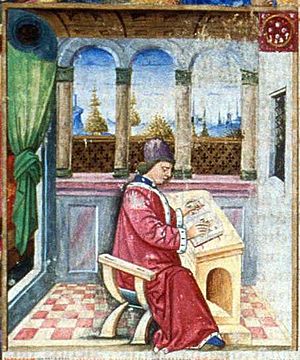Johannes Tinctoris facts for kids

Johannes Tinctoris (born around 1435 – died 1511) was a very important music theorist and composer. He came from the Low Countries (modern-day Belgium and Netherlands) during the Renaissance period. Many people think he was one of the most significant writers on music in Europe since Guido of Arezzo.
Contents
Life and Career
Tinctoris studied in Orléans, France. He was also the master of the choir there. He might have also led the choirboys in Chartres. In 1460, he worked at Cambrai Cathedral. Some people think he might have studied with the famous composer Guillaume Dufay there. Tinctoris moved to Naples, Italy, around 1472. He spent most of the rest of his life in Italy.
Besides music, Tinctoris was also a cleric (a church official), a poet, a mathematician, and a lawyer. Some records even say he was a skilled painter!
Musical Writings and Style
Tinctoris wrote many books about music. While he used ideas from older writers, his books give us a lot of detail about how composers made music in his time.
He created the very first dictionary of musical terms. It was called Diffinitorium musices. He also wrote about different musical modes (like scales). He wrote a book about musical proportions and three books about counterpoint. Counterpoint is about how different musical lines fit together. These books are very helpful for understanding how music changed from composers like Du Fay to Josquin des Prez. Tinctoris's writings were very important for other composers and music thinkers during the Renaissance.
Not much of Tinctoris's own music has survived. But the music we do have shows he liked complex and smooth polyphony. This is when many independent musical lines are played at the same time. He also liked to use very low notes in the bass voice. Tinctoris wrote different types of music, including masses, motets, and a few chansons (French songs).
Tinctoris's Eight Rules for Counterpoint
Tinctoris wrote down eight important rules for how to compose counterpoint. These rules are from his third book on the subject.
Rule 1: Start and end your music with perfect consonances. These are sounds that feel very stable and complete, like octaves or fifths. It's okay if a singer is making up a counterpoint part and ends with an imperfect consonance, but only if many voices are singing. Also, don't double the bass note with a sixth or an octave.
Rule 2: When the main melody (called the ténor) moves up or down, the other parts should move with it using imperfect or perfect consonances of the same kind. This means that moving in parallel thirds and sixths is good, but parallel fifths and octaves are not allowed.
Rule 3: If the ténor stays on the same note, you can add both perfect and imperfect consonances in the other parts.
Rule 4: The part you are adding (the counterpoint) should have a smooth and complete melody. This is true even if the ténor melody makes big jumps.
Rule 5: Don't put a cadence (a musical ending point) on a note if it stops the melody from developing nicely.
Rule 6: Don't repeat the same musical idea over a cantus firmus (a fixed melody). This is especially true if the cantus firmus itself already repeats that idea.
Rule 7: Try to avoid having two or more endings (cadences) on the same pitch one after another. This is important even if the cantus firmus would allow it.
Rule 8: In all your counterpoint, try to make it varied and interesting. Change the rhythm, the speed (tempo), and the endings (cadences). Use syncopation (off-beat rhythms), imitation (when one voice copies another), canons (strict imitation), and pauses. But remember, a simple song (chanson) uses fewer different styles than a motet, and a motet uses fewer styles than a mass.
Musical Compositions
Sacred Music
- Masses:
* Missa sine nomine #1 (for 3 voices) * Missa sine nomine #2 * Missa sine nomine #3 (missing parts) * Missa L'homme armé
- Motets:
* O Virgo miserere mei * Virgo Dei throno digna * Alleluya * Fecit potentiam * Lamentatio Jeremiae
Secular Music
- Helas
- Vostre regart
- O invida fortuna
- Le souvenir (for 4 voices)
- Le souvenir (for 2 voices)
- Tout a par moy
- De tous biens playne
- D'ung aultre amer
- Comme femme
Notable Writings
- The first dictionary of musical terms (Diffinitorum musices, around 1475). This book defined many musical words.
- An introduction to musical pitch and rhythm (Expositio manus and Proportionale musices). These books showed how complex rhythms might have been used in improvised music.
- A detailed explanation of the modal system (Liber de natura et proprietate tonorum). This book described the different musical modes or scales.
- His main book on intervals and counterpoint (Liber de arte contrapuncti). He created strict rules for using dissonances (sounds that feel unstable). He said they should only be used on unstressed beats or in special ways like suspensions and at cadences.
- A broad look at music's history and meaning (De inventione et usu musice). This book explored where music came from, its spiritual ideas, and how it was sung and played.
See also
 In Spanish: Johannes Tinctoris para niños
In Spanish: Johannes Tinctoris para niños

